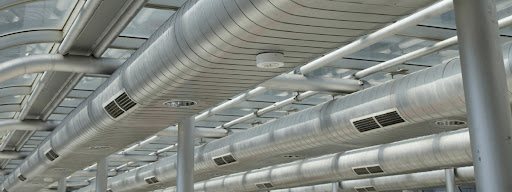
Modern shopping malls are architectural marvels with high-ceilinged atriums, open gallery voids, and multi-story structures. However, behind this stunning architecture lies significant engineering work. One of the most critical aspects, especially for fire safety, is smoke extraction.
More than 80% of fire-related fatalities result directly from smoke inhalation. In large-volume buildings like malls, this risk increases because smoke spreads quickly, accumulates, and complicates evacuation.
So how should smoke extraction be planned in such structures? What systems should be used, and what should be considered? Let’s explore.
1. Why Smoke Extraction is More Challenging in Large-Volume Buildings
-
High ceilings cause smoke to accumulate at the top and spread rapidly with heat.
-
Open gallery voids, escalators, and elevators facilitate smoke movement.
-
Large volume can make conventional ventilation systems insufficient.
-
Smoke direction becomes unpredictable → proper guidance is required.
Therefore, smoke extraction in large-volume buildings must be planned during the initial design phase.
2. Goal: Maintain Visibility and Clean Air Zones
Smoke extraction systems aim not only to remove smoke but also to:
-
Keep evacuation routes clear
-
Extend safe escape time
-
Facilitate firefighter intervention
Achieving these goals requires a controlled, layered, and zoned system.
3. Systems for Large-Volume Spaces
-
Natural Smoke Extraction Systems
-
Roof vents, smoke dampers, and breakable glass panels allow smoke to exit naturally.
-
Operates automatically with fire heat, no electricity required.
-
Effective for atriums and gallery voids.
-
Note: Must plan for wind and external air conditions.
-
-
Mechanical Smoke Exhaust Systems
-
Smoke extraction fans rated up to 400 °C actively remove smoke.
-
Automatically activates based on fire scenarios.
-
Extracts smoke from desired points.
-
Advantage: Smoke direction can be controlled.
-
Requirement: Must be supported by a generator or UPS.
-
-
Pressurization Systems
-
Positive pressure is applied to staircases, elevators, and escape corridors.
-
Prevents smoke entry, enabling safe evacuation.
-
Legal requirement: Must comply with TS EN 12101 in certain areas.
-
-
Jet Fan Systems (Propulsion System)
-
Used in large parking areas or long gallery corridors.
-
Pushes smoke in a specific direction without ductwork.
-
Provides cost and installation advantages.
-
4. Mandatory Planning Elements
-
Zoning: Divide the mall volume into separate smoke extraction zones. Each zone should have its own fan, damper, and scenario.
-
Smoke Curtains: Automatic fire curtains prevent smoke from descending in atriums and galleries.
-
Simulation Support (CFD): Volume airflow simulations guide planning according to smoke movement and speed.
5. Integration with Automation Systems
Smoke extraction systems must be integrated with fire detection and building automation:
-
Fire Detection: Detects smoke/heat and sends signals
-
Building Automation System (BMS): Coordinates fans, dampers, and curtains
-
Scenario-Based Control: Determines which zones are active or inactive
All systems must be powered by uninterrupted energy sources (generator/UPS).
6. Maintenance, Testing, and Compliance
-
Periodic Tests: Smoke fans must be tested under load at least once a year.
-
Fire Dampers: Check manual and automatic operation.
-
Legal Compliance: Follow TS EN 12101, NFPA 92, and local fire protection regulations.
-
Documentation: Required for permits and insurance processes.
7. Advantages of Proper Planning
-
Ensures life safety
-
Facilitates firefighter intervention
-
Fully meets legal requirements
-
Enhances mall reputation and reliability
-
In mixed-use residential + commercial projects, adds property value
Architectural Beauty Crowned with Technical Safety
No matter how impressive the mall architecture, without proper smoke extraction, everything is at risk. A well-designed smoke extraction system is an invisible yet life-saving safety network.
Remember: Firefighting takes minutes; smoke control starts in the first second.
Ilker KURAN
Alperen Engineering Ltd.







